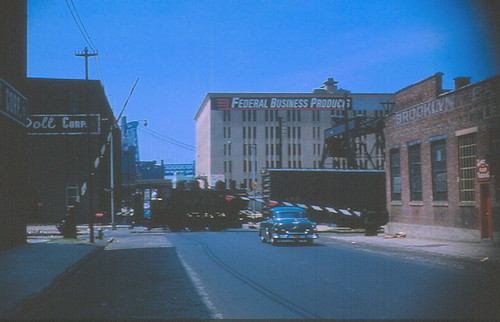Why GL Calls Brooklyn "Post-Industrial"

An outraged comment on an otherwise innocent photo of a tagged up van this weekend from someone who clearly isn't a regular reader got us to thinking. The commenter took significant umbrage in our use of the phrase "post-industrial" to describe Brooklyn. Specifically:
Why do you call this blog 'post-industrial' when there are thousands and THOUSANDS and THOUSANDS of people who work in factories, mills, etc etc right near you and many MANY more within a few miles? Just because YOU and most of your readers might work in offices?Ignoring the last jab and taking the compliment about using rhetoric nicely, "Rosie's" anger got us thinking about the post-industrial city/region/nation in which we live. First, what do we mean by post-industrial? Wikipedia offers a succinct definition, noting that a post-industrial society is marked by a rapid increase in the size of the service sector vis a vis manufacturing and in the amount of information technology. Other definitions include the fact that the majority of the workforce no longer works in manufacturing.
Nice use of rhetoric, when the condo comes I hope your the first to get thrown out on your ass.
peace,
Rosie the Riveter
So, what are the job trends in Brooklyn? Manufacturing accounts for 7 percent of the jobs in our borough. In June 1958, there were 220,000 manufacturing jobs in Brooklyn. The total in 2004 was 31,044. The largest sector in Brooklyn, according to the Brooklyn Chamber of Commerce, is "health care and social assistance" with 127,000 jobs. The second largest sector is retail with 52,871 jobs.
The entire American economy has been in a post-industrial phase since the 1970s. In 2004, the total number of manufacturing jobs stood at 14.3 million, down 3 milliion since 2000 and 5.2 million since 1979.
We do not intend a discussion about whether this is a good thing or a bad thing--for the record, we believe it's a bad thing--but simply wish to state that it is reality and that global forces are behind the shift. It's vital that economic development officials develop strategies to preserve manufacturing jobs in Brooklyn and the other boroughs, and we have serious reservations about Bloomberg administration policies speeding the demise of manufacturing in some nabes. While it makes sense to target certain areas of the city for efforts to preserve manufacturing, there is little effort to protect existing industry in neighborhoods where the land is deemed more valuable for luxury condos.
While Brooklyn may have industry and tens of thousands of manufacturing jobs that are worth preserving, our borough, like our entire country, is post-industrial. For better or worse.
[The photo above, which is Kent Avenue in Williamsburg circa 1962, shows the Austin & Nichols Warehouse, aka 184 Kent, in the backgroun. This photo was posted at the Brooklyn Eastern District Terminal page, which is full of incredible historic photos of industrial Williamsburg, and came to our attention via a post on I'm Not Saying's blog.]

0 Comments:
Post a Comment
<< Home